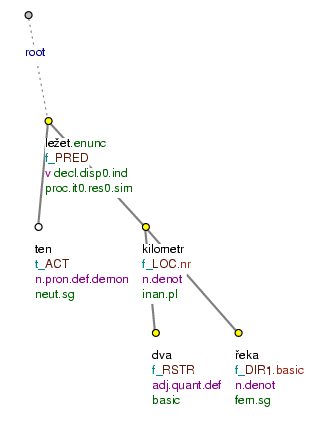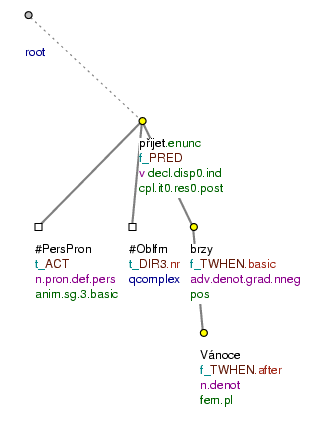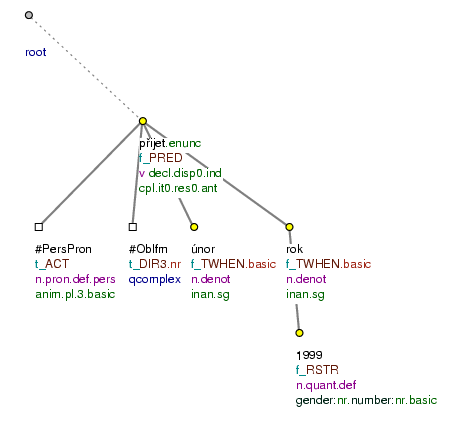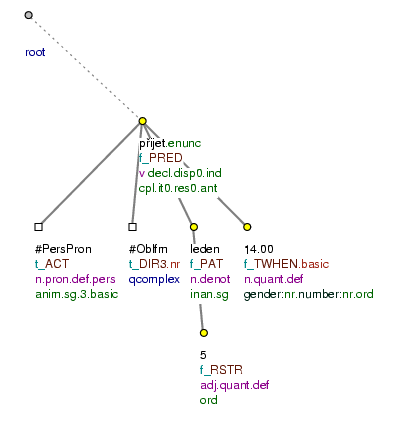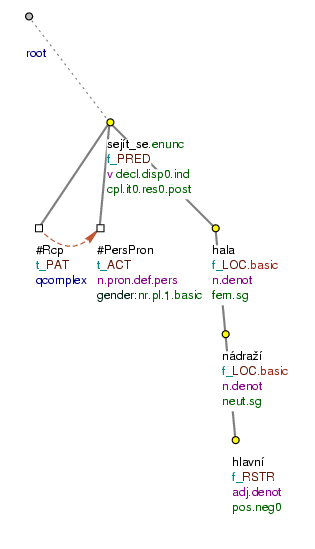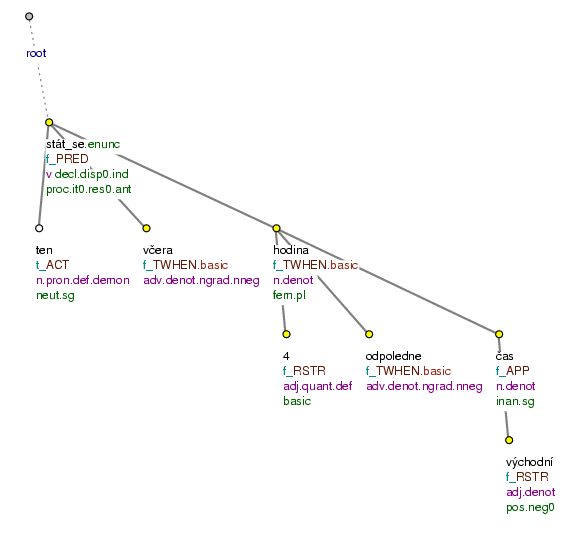This subsection deals with the annotation rules for those ambiguous structures in which several adjacent modifications with the same function (usually locative or temporal modifications) enter (or do not enter) into the same semantic relations. Their mutual relation is not an easy issue. Tthe following three cases can be found:
-
two temporal or locative/directional modifications in apposition,
-
one temporal or locative/directional modification dependent on another temporal or locative/directional modification (see Section 11.3.1, "A temporal or locative/directional modification dependent on another temporal or locative/directional modifcation"),
-
several sister nodes with a temporal or locative/directional meaning (see Section 11.3.2, "Two sister modifications with temporal or locative/directional meaning").
Only the so-called loose connections (separated by a comma or by an appositional conjuction; see Section 6.2, "Coordination and apposition") are represented as apposition of several modifications. Examples:
Zůstal doma, v Krkonoších (=lit. (He) stayed at_home, in (the) Giant_Mountains.)
Other cases are considered either several sister modifications or cases in which one modification is modified by another modification.
11.3.1. A temporal or locative/directional modification dependent on another temporal or locative/directional modifcation
We represent the following cases as cases in which one temporal or locative/directional modification depends on another temporal or locative/directional modification:
-
the second modification is in the genitive.
These are cases in which the second modification (temporal, locative/directional or another) has a genitive form. The second modification depends on the first modification and its functor is
APP.This concerns particularly those temporal expressions in which the specification of the day is followed by the month, year and so on but also other cases.
Examples:
Přijel ve čtvrtek 5. ledna .
APP1997 (=lit. (He) arrived on Thursday 5th January 1997.) Fig. 6.189Stalo se to 4. ledna roku.
APP1935 (=lit. Happened - it on 4th January -1935.)V lednu roku.
APP1945 byla krutý mráz (=lit. In January - 1945 was cruel (the) frost.) -
expression of an extent.
These are the cases in which the first modification has the form of the so-called extent or temporal accusative (or by its prepositional variant) which is folled by a prepositional phrase. The accusative cannot occur alone in the sentence; it constitutes a single temporal or locative/directional modification together with the following prepositional phrase. The second modification is represented as dependent on the first one. These modifications have temporal, extent or locative/directional functors.
Examples:
Leží to dva kilometry.
LOCod řeky.DIR1(=lit. (It) is_located two kilometres from (the) river.) Fig. 6.190Vždyť jsi sotva hodinu.
LOCcesty od Hrusic.DIR1(=lit. - (you) are hardly one_hour far from Hrusice.)Je to pět minut.
LOCod pláže.DIR1(=lit. (It) is five minutes from (the) beach.)Je to kolem pěti minut.
LOCod pláže.DIR1(=lit. (It) is about five minutes from (the) beach.)Leží to na dva kilometry.
LOCod řeky.DIR1(=lit. (It) is_located about two kilometers from (the) river.)Oblékla se půl.
TWHENhodiny před začátkem.TWHENpředstavení (=lit. (She) got_dressed - half an hour before (the) beginning (of) (the) performance.)Odjela dva měsíce.
TWHENpřed porodem.TWHEN(=lit. (She) left two months before childbirth.)Zůstaňte ležet dvě hodiny.
THLpo zákroku.TWHEN(=lit. Keep lying (for) two hours after (the) operation.)Doběhl pět minut.
TWHENpo odjezdu.TWHENvlaku (=lit. (He) came five minutes after (the) departure (of) (the) train.) -
the second modification can be considered a valency modification of the first one.
These are cases in which one of the modifications is modified by the other. Also cases when the second modification is other than temporal or locative/directional and could be considered a valency modification of the first one belong here.
These constructions are parallel to those expressing an extent; the extent or temporal accusative is substituted by an adverb, however.
Examples:
Přijel brzy soon.
TWHENpo Vánocích.TWHEN(=lit. (He) arrived soon after Christmas.) Fig. 6.191Odehrálo se to daleko.
LOCod Moskvy.DIR1(=lit. Happened - (it) far from Moscow.)Našel to hluboko .
LOCpod povrchem.LOC(=lit. (He) found it deep under (the) surface.)Pojedeme na západ (=západně).
DIR3od Prahy.DIR1(=lit. (We) will_go - west (=westwards) from Prague.)
Figure 6.189. Mutual relation of two temporal modifications
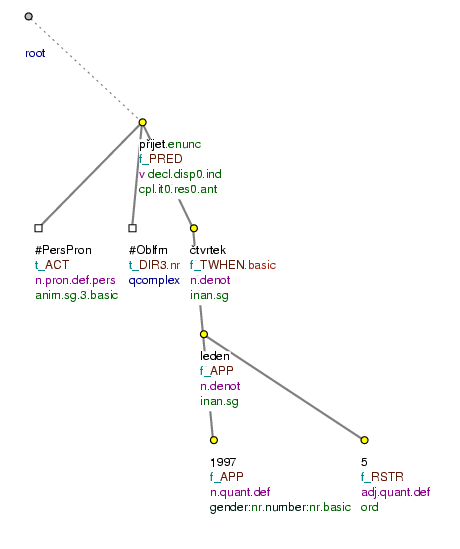
Přijel ve čtvrtek 5. ledna 1997. (=lit. (He) arrived on Thursday 5th January.)
If there are two (or more) temporal or locative/directional (or other) modifications present in the sentence at the same time and each of the modifications is relatively independent, they are represented as sister modifications dependent on the same governing node. Their word order can be changed without any change of meaning; any of the modifications can be omitted without any damage to the grammatical structure of the sentence. Both modifications usually relate to the same moment or to the same location, one of them is more general, the other one is more specific.
Examples:
Sejdeme se na Hlavním nádraží.LOC v hale.LOC (=lit. (We) shall_meet - at (the) Central Station in (the) entrance_hall.) Fig. 6.192
Lopata leží vzadu.LOC u plotu.LOC (=lit. (The) shovel is in_the_back by (the) fence.)
Sejdeme se v Praze.LOC na Václavském náměstí.LOC (=lit. (We) will_meet - in Prague in Wenceslas square.)
Přijeli v únoru.TWHEN v roce.TWHEN 1999 (=lit. (They) arrived in February 1999.) Fig. 6.193
Přijel 5. ledna.TWHEN ve 14,00.TWHEN (=lit. (He) arrived (on) 5th January at 2pm.) Fig. 6.194
Vloni .TWHEN v lednu TWHEN se konala conference. (=lit. Last_year in January - took_place (the) conference.)
Přijde zítra.TWHEN k večeru.TWHEN (=lit. (He) will_come tomorrow toward (the) evening.)
Odešel brzy.TWHEN ráno.TWHEN (=lit. (He) left early (in) (the) morning.)
Figure 6.192. Mutual relation of two locative/directional modifications
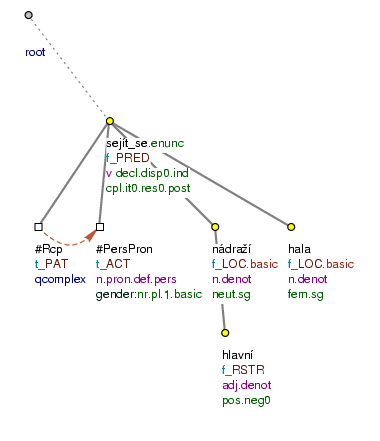
Sejdeme se na Hlavním nádraží v hale. (=lit. (We) shall_meet - at (the) Central Station in (the) entrance_hall.)
In some cases the mutual relations between the temporal or locative/directional modifications expressed by adverbs and prepositional phrases are ambiguous. There are often several possible interpretations.Therefore, it is necessary to consider the sentence in the context. Cf.:
-
V únoru v roce 1948 jsme nebyli v republice (=lit. In February in - 1948 (we) - were_not in (the) republic.)
= V únoru, a to v roce 1948 jsme nebyli v republice (=lit. In February and that in - 1948 (we) - were_not in (the) republic.)
= V únoru, který byl v roce 1948, jsme nebyli v republice (=lit. In February that was in - 1948 (we) - were_not in (the) republic.)
The construction can be interpreted in the following way: the second modification specifies the first one, therefore, it depends on it. However, it is also possible to interpret the construction as two temporal sister modifications. It depends on the interpretation: if the interpretation is in February in 1948, there are two sister modifications represented in the construction; if the interpretation is in February that was in 1948 the second modification depends on the first one.
-
Bydlí v chaloupce u lesa (=lit. (He) lives in (a) little_cottage by (the) wood.).
= Bydlí v chaloupce, a to u lesa (=lit. (He) lives in (a) little_cottage, and that_is by (the) wood.)
= Bydlí v chaloupce, která je u lesa (=lit. (He) lives in (a) little_cottage which is by (the) wood.)
The construction can be interpreted in the following way: the second locative modification specifies the first one. However, we can also interpret this case as two sister modifications with a locative meaning. It depends on the interpretation: if the interpretation is he lives in a little cottage, which is by the wood two sister modifications are represented in the construction; if the interpretation is in a little cottage that is located by the wood the second modification depends on the first one.
These examples differ from those described in Section 11.3.2, "Two sister modifications with temporal or locative/directional meaning" in that the word order is fixed. The order of the two modifications cannot be changed without the change in meaning. Cf.:
-
Sejdeme se v hale na nádraží (=lit. (We) shall_meet - in (the) entrance_hall at (the) station.).
= Sejdeme se v hale, která je na nádraží (=lit. (We) shall_meet - in (the) entrance_hall that is at (the) station.)
= Sejdeme se v hale, a to na nádraží. (=lit. (We) shall_meet - in (the) entrance_hall, and that_is at (the) station.)
Two interpretations of the relations between the locative modifications are possible. The mutual relation of the two locative modifications can be interpreted in the following way: the modification that comes second in the sentence specifies the modification that comes first (cf. Fig. 6.195 ), or both modifications can be considered relatively independent and they can be represented as sister modifications.
-
Sejdeme se na nádraží v hale. (=lit. (We) shall_meet - at (the) station in (the) entrance_hall.).
= Sejdeme se na nádraží, a to v hale (=lit. (We) shall_meet - at (the) station, and that in (the) entrance_hall.)
The reversed word order makes only one interpretation possible. Therefore the two modifications are represented as sister nodes. This case is described in Section 11.3.2, "Two sister modifications with temporal or locative/directional meaning". Cf. Fig. 6.192.
Relations within groups of adverbial modifications are very complicated. In constructions of the types described above, the analysis depends on the annotator.
Examples of complicated temporal and locative/directional modifications:
Stalo se to včera ve čtyři hodiny odpoledne východního času. (=lit. Happened - it yesterday at 4 - pm eastern time.) Fig. 6.196
Přijeli v neděli dopoledne 3. září. (=lit. (They) arrived on Sunday (in) (the) morning 3rd September.).
Každý den při mši sv. v devět hodin ráno setkává se kněz se svými věřícími. (=lit. Every day at (the) mass holy at nine -am meets - (a) priest - his believers.)
Vytvořili nové soubory v pátek večer a o víkendu. (=lit. (They) created new files on Friday night and at (the) weekend.)
